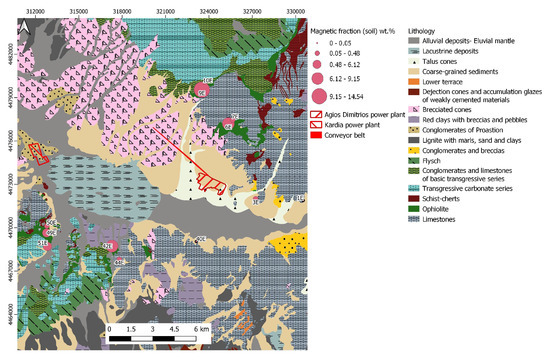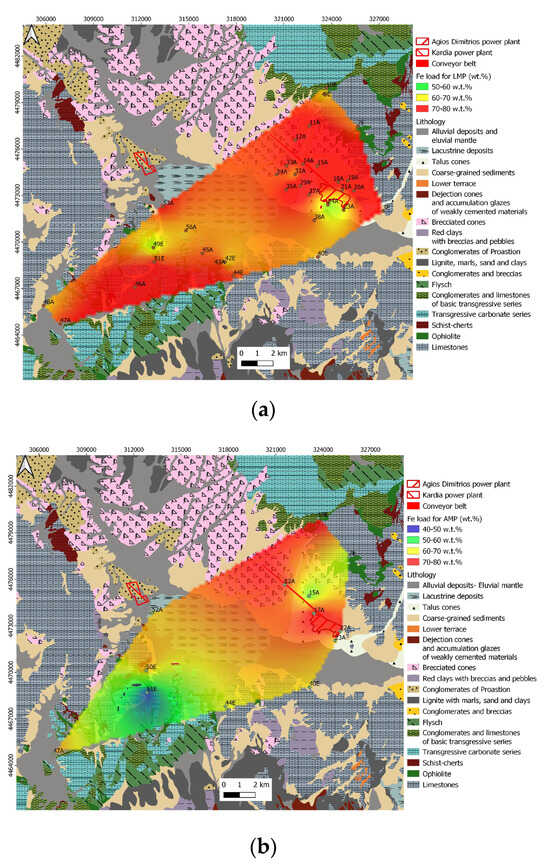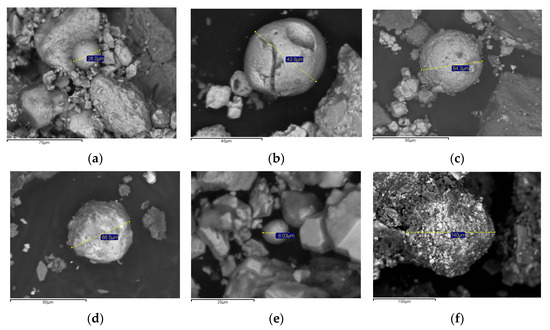Abstract
Magnetic particles were separated from soil and sediment samples from the Sarigiol basin. The sources of their highest values are ophiolite complexes and fly ash dispersion while magnetite is the dominant mineral. Ιron is the dominant element of magnetic particles and minor amounts of Mn, Ti and Cr are presented in anthropogenic magnetic particles. The highest values of iron load are shown near to a power station and close to the locations of the ophiolite complexes. Anthropogenic activities in the research area are responsible for the presence of anthropogenic magnetic particles in the upper horizons of the Sarigiol basin.
1. Introduction
Over the past decades, industrial and urban development have brought airborne particulates to the forefront. They have caused environmental concern in the scientific community due to the significant extent of air, but also soil and water pollution. Magnetic particles, a class of airborne particulates, are also derived from the fly ash produced via the combustion of fossil fuels in power plants. Magnetic particles consist mainly of magnetic minerals such as magnetite and maghemite. In particular, these strong magnetic minerals are often causally related to heavy metals, such as Cu, Pb, Zn, Cd and Cr [1], while Ni, V and Zn are closely associated with fly ash particles with magnetic properties. Heavy metals emitted via anthropogenic activities are transported to terrestrial ecosystems through atmospheric deposition. They are incorporated into the soil and can enrich aquifers or water bodies. According to a recent report released by the European Environment Agency, air pollution kills more than 1200 children and teenagers annually in Europe, while more than 60% of pollution-related disease and death are due to cardiovascular disease [2].
Using magnetic particles to assess the level of pollution in an area is one of the cheapest and fastest ways to carry this out. Magnetic particles can absorb and transport pollutants such as Ni, Cr, As and other heavy metals and organic compounds due to their large surface area [3]. The linkage between heavy metals and magnetic particles can be used to identify and determine from the concentration of these pollutants from anthropogenic activities such as fossil fuel combustion, iron/steel metallurgy or even vehicular emissions. Heavy metals with potential toxic effects are found to be concentrated in these magnetic particles. Obviously, magnetic particles from anthropogenic activities are relatively more hazardous than those of lithogenic origin.
Northwestern Greece hosts the country’s largest lignite center. This area has been of environmental concern, as soil, water, and air pollution is intense. Heavy air pollution problems have been demonstrated, that are mainly attributed to the extensive mining and burning of lignite for energy production [4]. Groundwater quality, and the soil and sediments of the Sarigiol basin in northwestern Greece have been severely deteriorated by high concentrations of hexavalent chromium originating from the dispersion of fly ash from the local lignite-burning power plant [5,6].
The aim of the present study is to depict the pollution in the upper soil/sediment horizons in the area of Sarigiol basin in northwestern Greece through magnetic particles and their heavy metal load. Magnetic particles were separated from soil and sediment samples in order to determine their mineralogical composition via X-ray diffraction (XRD). Their chemical composition was determined via elemental point EDX analysis, while the morphological characteristics of anthropogenic magnetic particles were observed via scanning electron microscopy (SEM). Additionally, appropriate software was used to map the spatial distribution of the magnetic fraction as well as its iron load, and then the corresponding maps were extracted.
2. Materials and Methods
The Sarigiol basin is located in Northern Greece and is the southern part of the Ptolemais basin. The perimeter of the research area is approximately 73 km. The center of the basin consists of quaternary formations such as sands, talus/brecciated cones, and alluvial deposits as well as clay formations. Around the perimeter of the basin, there is a strong presence of limestone formations, while in the NE and SW parts there are presences of ultrabasic rocks such us ophiolite complexes.
Sampling was carried out in the Sarigiol basin at 59 different locations. In total, 47 surface (0–10 cm) sediment samples and 12 soil samples from the weathering mantle above the bedrock were collected. For the separation of the magnetic fraction, 20 g of representative material (<2 mm) was slightly disaggregated in an agate mortar by hand. This material was then mixed with 250 mL of deionized water and 10 mL of a dispersing agent ((NaPO3)6, 50 g/L), and placed with a magnet in a beaker to extract the strongly magnetic particles, using a magnetic stirrer at a low speed (<100 rpm) without heat in order to achieve particle dispersion. Separation was repeated three times, after 5, 2, and 1 min intervals [7]. The magnetic particles extracted from each sample were dried at 110 °C to a constant weight and then weighed and placed in plastic vials for a mineralogical study. Surfer was used to map the spatial distribution of the magnetic fraction and the iron load via spatial interpolation kriging to create grids (for sediment samples and iron load) and later, to create the maps, the grids were imported into QGIS 3.16.15. The extracted maps were presented through a scaled color gradation of filled contours (for sediment samples and iron load) and through colored circles with increased diameters (for soil samples) based on the ranges of the magnetic fraction of each sample.
The chemical composition of the magnetic fraction was determined via elemental point EDX analysis using the scanning electron microscope (JEOL JSM6390LV) of the Electron Microscopy Laboratory of the Aristotle University of Thessaloniki, with which random anthropogenic magnetic particles were also observed morphologically. Afterwards, the mineralogical composition of the magnetic fraction was determined via X-ray diffraction (XRD) on randomly oriented powder samples, which were pulverized by hand in an agate mortar. The ICDD (International Center of Diffraction Data PDF4+) diffraction files were used as a database for the identification of the different mineralogical phases.
3. Results
Based on the results of the mineralogical analysis of the magnetic fraction, the major mineral phase of the studied samples is magnetite (42–59 wt.%), while serpentine is found in significant amounts. Clay minerals, calcite, quartz, olivine and pyroxene are also present in minor amounts. Magnetite has a dual origin, as its possible sources are the ophiolite complexes in the NE and SW parts of the area but also the fly ash of the two power stations located in the study area, Agios Dimitrios, in the E part and Kardia in the N part. Serpentine and olivine are of lithogenic origin, as they are components of the surrounding ultrabasic rocks. Quartz, pyroxene, calcite and clay minerals are probably components of the lithological formations of the study area, which is particularly enriched with these minerals; however, they are also found to be contained in the fly ash of the Agios Dimitrios and Kardia power stations as components of the burning lignite that are transferred to fly ash due to the incomplete combustion of lignite in some parts of the burning unit [8].
The separation of magnetic particles in the studied samples shows that the magnetic fraction for the soil samples has an average value of 3.36 wt.%, while for the sediment samples it is 0.67 wt.%. The highest values of the magnetic fraction of the soil samples are attributed to the presence of magnetic minerals in the parent rocks from which the overlying soils are derived (Figure 1). On the other hand, the distribution of the magnetic fraction of the sediment samples showed the highest values in the NE and SW part of the study area (Figure 2). The ophiolitic rocks in the NE and SW part of the research area seem to be the main source of the highest values of the magnetic fraction; however the contribution of the two power plants, through the dispersion of the fly ash, cannot be excluded. Opaque minerals such as hematite, spinels and pyrite are contained in the lignite of the Ptolemais basin and they are transferred to the fly ash produced after its combustion at the power plants of the area [9].

Figure 1.
Distribution of magnetic fraction of surface soil samples in the study area (“E” letter refers to soil samples).

Figure 2.
Distribution of magnetic fraction of sediment samples (“A” letter refers to sediment samples) in the study area (the lithology is the same as that in Figure 1).
According to the EDX elemental analysis, iron is the dominant element of the total magnetic fraction with an average value greater than 60 wt.%. Figure 3a,b shows the distribution of the iron load for lithogenic (LMP) and anthropogenic magnetic particles (AMPs), respectively. The highest iron values for the LMP (>70 wt.%) occur in the NE and SW parts of the basin with the ophiolite complexes in the NE and SW being the sources of origin, respectively. The highest iron values for AMPs (>70 wt.%) in the N and E parts of the basin are attributed to the activity of the Agios Dimitrios power plant and the presence of the ash conveyor belt in combination with the temporary ash deposition sites. Elements such as Si, Ca, Mg and Al were also found in significant amounts. All of these elements are derived from the mineral phases of the lithological units in which sampling was carried out but are also attributed to fly ash particles from the power plants located in the study area. In addition, according to the geochemical analyses of the AMPs, the average values of heavy metals such as Mn, Ti and Cr were found to be 4.95, 3.28 and 2.68 wt.%, respectively. Their source is the fly ash dispersed from the two power plants located in the study area and subsequently incorporated into the upper layers of the soil, proving the impact of their activity on the specific area.

Figure 3.
Distribution of iron load for (a) lithogenic magnetic particles (LMP) and (b) anthropogenic magnetic particles (AMPs). Letters “E” and “A” refer to soil and sediment samples, respectively.
During the morphological observation of the magnetic fraction using SEM, a significant number of spheres were identified. This particular morphology of the magnetic particles corresponds to the combustion of fossil fuels at high temperatures and is essentially part of the fly ash produced during combustion. The average size of the fly ash particles ranges from 1 to 150 µm [10]. The minimum and maximum diameters of the particles studied were 4.7 and 140 μm, respectively. The majority of spheres are between 10–50 µm (Figure 4a,b), a significant number of them are between 50–80 µm (Figure 4c,d) and fewer are <10 or >80 µm (Figure 4e,f). One of the main factors controlling sphere size is the composition of the initial coal [11].

Figure 4.
(a–f) Anthropogenic magnetic particles in the form of spheres from the studied samples of the Sarigiol basin.
4. Conclusions
Soil (12) and sediment (47) samples were collected from 59 different locations of the Sarigiol basin in order to study the magnetic particles, and their spatial distribution, as well as the heavy metal load in the magnetic particles originating from anthropogenic activities. The highest values of the magnetic fraction of the soil samples are attributed to the presence of magnetic minerals in the parent rocks from which the overlying soils are derived, while for the magnetic fraction of the sediment samples, the highest values were found in the NE and SW part of the Sarigiol basin. The ophiolitic rocks in the NE and SW part of the study area are the main source for the magnetic fraction; however, the contribution of the Kardia and Agios Dimitrios power plants cannot be excluded, and are due to the transportation and dispersion of fly ash. Soil permeability and wind direction are factors that enhance the deposition and integration of the fly ash.
Iron is the dominant element in the magnetic fraction. For lithogenic magnetic particles (LMP), the highest values of iron load in the NE and SW part of the basin are attributed to the magnetic minerals of the ophiolitic rocks in the study area, while for the anthropogenic magnetic particles (AMPs), the highest values for iron load and that of other elements such as Mn, Cr, and Ti in the N and E parts of the basin are attributed to the activity of the Agios Dimitrios power plant and the presence of the ash conveyor belt in combination with the temporary ash disposal sites. The majority of AMPs belong to the size range of fly ash particles, while a morphological observation of random AMPs showed that their surface is simple or more complex and corresponds to the combustion of fossil fuels at high temperatures. The mapping of the dispersion of magnetic particles and the distribution of the chemical elements they contain is a very useful tool for assessing the environmental impact of anthropogenic activities in an area, specifically in the Sarigiol basin.
Author Contributions
Conceptualization, C.C. and N.K.; methodology, C.C., L.P. and N.K.; data curation, C.C.; writing—original draft preparation, C.C.; writing—review and editing, D.V., A.D. and N.K.; visualization, C.C.; supervision, N.K. All authors have read and agreed to the published version of the manuscript.
Funding
This study is part of the research of the first author, C. Chrysakopoulou, which was financed by Hellenic Petroleum S.A through the program “Grants Hellenic Petroleum S.A” and in collaboration with the research committee AUTh.
Institutional Review Board Statement
Not applicable.
Informed Consent Statement
Not applicable.
Data Availability Statement
https://digital.lib.auth.gr (accessed on 1 September 2023).
Conflicts of Interest
The authors declare no conflict of interest.
References
- Yang, T.; Liu, Q.; Li, H.; Zeng, Q.; Chan, L. Anthropogenic magnetic particles and heavy metals in the road dust: Magnetic identification and its implications. Atmos. Environ. 2010, 44, 1175–1185. [Google Scholar] [CrossRef]
- Münzel, T.; Hahad, O.; Daiber, A.; Landrigan, P.J. Soil and water pollution and human health: What should cardiologists worry about? Cardiovasc. Res. 2022, 119, 440–449. [Google Scholar] [CrossRef] [PubMed]
- Bourliva, A.; Aidona, E.; Papadopoulou, L.; Ferreira da Silva, E.; Patinha, C.; Sarafidis, C.; Kantiranis, N. An integrated approach combining magnetic, geochemical and particle-based techniques to assess metal(loid) loadings in urban venues frequented by children. Sci. Total Environ. 2022, 822, 153600. [Google Scholar] [CrossRef] [PubMed]
- Iordanidis, A.; Buckman, J.; Triantafyllou, A.G.; Asvesta, A. Atlas of Airborne Particles from Kozani Area, Northern Greece. In Proceedings of the 11th International Congress of the Geological Society of Greece, Athens, Greece, 23 May 2007. [Google Scholar]
- Kazakis, N.; Kantiranis, N.; Kalaitzidou, K.; Kaprara, E.; Mitrakas, M.; Frei, R.; Vargemezis, G.; Tsourlos, P.; Zouboulis, A.; Filippidis, A. Origin of hexavalent chromium in groundwater: The example of Sarigkiol Basin, Northern Greece. Sci. Total Environ. 2017, 593, 552–566. [Google Scholar] [CrossRef] [PubMed]
- Kazakis, N.; Kantiranis, N.; Kalaitzidou, K.; Kaprara, E.; Mitrakas, M.; Frei, R.; Vargemezis, G.; Vogiatzis, D.; Zouboulis, A.; Filippidis, A. Environmentally available hexavalent chromium in soils and sediments impacted by dispersed fly ash in Sarigkiol basin (Northern Greece). Environ. Pollut. 2018, 235, 635–637. [Google Scholar] [CrossRef] [PubMed]
- Grimley, D.A.; Lynn, A.S.; Brown, C.W.; Blair, N.E. Magnetic Fly Ash as a Chronological Marker in Post-Settlement Alluvial and Lacustrine Sediment: Examples from North Carolina and Illinois. Minerals 2021, 11, 476. [Google Scholar] [CrossRef]
- Filippidis, A.; Georgakopoulos, A.; Kassoli-Fournaraki, A. Mineralogical components of some thermally decomposed lignite and lignite ash from the Ptolemais basin, Greece. Int. J. Coal Geol. 1996, 30, 303–314. [Google Scholar] [CrossRef]
- Kassoli-Fournaraki, A.; Georgakopoulos, A.; Filippidis, A. Heating experiments of the Ptolemais lignite in the temperature range from 100 °C to 500 °C. Neues Jahrb. Mineral. Monatshefte 1992, 11, 487–493. [Google Scholar]
- Yuan, Q.; Liu, Z.; Zheng, K.; Ma, C. Civil Engineering Materials from Theory to Practice, 1st ed.; Elsevier: Amsterdam, The Netherlands, 2021; pp. 59–204. [Google Scholar]
- Juda-Rezler, K.; Kowalczyk, D. Size Distribution and Trace Elements Contents of Coal Fly Ash from Pulverized Boilers. Pol. J. Environ. Stud. 2013, 22, 25–40. [Google Scholar] [CrossRef]
Disclaimer/Publisher’s Note: The statements, opinions and data contained in all publications are solely those of the individual author(s) and contributor(s) and not of MDPI and/or the editor(s). MDPI and/or the editor(s) disclaim responsibility for any injury to people or property resulting from any ideas, methods, instructions or products referred to in the content. |
© 2023 by the authors. Licensee MDPI, Basel, Switzerland. This article is an open access article distributed under the terms and conditions of the Creative Commons Attribution (CC BY) license (https://creativecommons.org/licenses/by/4.0/).